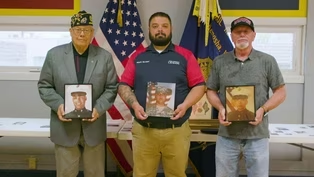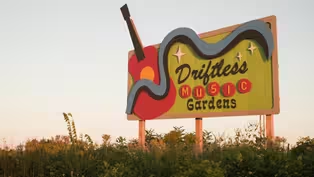
What kind of art was in the trenches during WWI?
Clip: Season 12 Episode 5 | 3m 49sVideo has Closed Captions
The museum holds 60,000 books and 40,000 artifacts on military history.
Angela visits the Pritzker Military Museum & Library near Kenosha, which houses over 60,000 books and 40,000 artifacts. Director of Museum Collections Dustin DePue shares WWI trench art and a Brodie helmet from soldier Samuel Rigoulot, while manager Rachel Marcella highlights exhibits on women of color who served in the armed forces.
Problems playing video? | Closed Captioning Feedback
Problems playing video? | Closed Captioning Feedback
Wisconsin Life is a local public television program presented by PBS Wisconsin
Funding for Wisconsin Life is provided by the Wooden Nickel Fund, Mary and Lowell Peterson, A.C.V. and Mary Elston Family, Stanley J. Cottrill Fund, UW Health, donors to the Focus Fund for Wisconsin Programs, and Friends of PBS Wisconsin.

What kind of art was in the trenches during WWI?
Clip: Season 12 Episode 5 | 3m 49sVideo has Closed Captions
Angela visits the Pritzker Military Museum & Library near Kenosha, which houses over 60,000 books and 40,000 artifacts. Director of Museum Collections Dustin DePue shares WWI trench art and a Brodie helmet from soldier Samuel Rigoulot, while manager Rachel Marcella highlights exhibits on women of color who served in the armed forces.
Problems playing video? | Closed Captioning Feedback
How to Watch Wisconsin Life
Wisconsin Life is available to stream on pbs.org and the free PBS App, available on iPhone, Apple TV, Android TV, Android smartphones, Amazon Fire TV, Amazon Fire Tablet, Roku, Samsung Smart TV, and Vizio.
Providing Support for PBS.org
Learn Moreabout PBS online sponsorship- I'm at the Pritzker Military Museum and Library near Kenosha, learning about their efforts to be recognized as a hub for military history in the Midwest.
[rousing marching band music] I met with Rachel Marcella, Manager of Programs and Events, to discover what visitors can expect when they arrive here.
- Rachel Marcella: So as soon as they come in, you are right in our exhibit space.
So they kinda just get the whole experience.
We have over 40,000 artifacts in our own collection that we'll put on display.
We're not just a museum, we're also the library.
So the library has 60,000 books.
We usually have a couple exhibits that are rotating through.
Right now, we have an exhibit highlighting women of color who have served.
- Angela: I love that because I think we all maybe have an idea in mind when we think of who represents the armed services, the armed forces that you all are like, "Yes, and these other individuals also represent."
And so I appreciate the intentionality that you all take with uplifting those stories that aren't often heard.
- We, as a country, have gone through so much and we will continue to go through so much.
And it's so easy to think that, like, I am just living my piece in it, but all of us as a community are interwoven, and it really helps strengthen the ties, I think, between the community.
[rousing marching band music] - Angela: To explore that military history, I met up with Dustin DePue, Director of Museum Collections, who showed me a few items found in archives here, starting with trench art.
- Dustin DePue: Trench art kind of became popularized during World War I, as there was millions of artillery shells littering the battlefields, and so soldiers had a lot of time on their hands.
They would often fashion it into little art pieces, use those to try to sell or trade.
This is a piece that's been sort of turned into, like, a vase of some kind.
It is from a French 75-millimeter artillery shell casing.
It says "Verdun 1918."
Now, Verdun is a city in northeastern France, and it was the site of the longest battle in World War I. So a lot of times, a piece like this would've been made after the war to commemorate that battle.
- Well, and that's interesting, because you don't often think about the materials that are literally left behind after battles and what happens to them, other than they just become waste.
- That's right.
- So the fact that they're being repurposed.
- Yeah, exactly.
I have another item from World War I. We've got a little bit of a theme going today.
What we have here is what is called a Brodie helmet.
It's sometimes called a Doughboy helmet as well.
This helmet was worn by Samuel Rigoulot, who was in the 3rd Infantry division and was present in what's called the Second Battle of the Marne.
It was an incredibly important and decisive battle in World War I. He was the victim of a chemical warfare attack, and was forced off the front lines and had to convalesce with a French family until he sort of healed up.
He did survive.
- And I'm assuming his family donated this.
- That's correct, yes.
Yeah, so this is a real piece of history here.
The last thing I have is a lot more simple.
It is a mess kit, so it's an American mess kit.
So our Doughboys, as we call them, when they were going overseas, you know, they would have this kit with them, and this is an instance of, you can see some etching in there.
- So someone personalized their mess kit.
- Dustin: Exactly.
You can see the Eiffel Tower on there.
You can see a bald eagle.
- Angela: From equipment used on the battlefield to art found in the trenches, Pritzker Military Museum has a treasure trove of military history to explore.
Preserving the family military legacy
Video has Closed Captions
Clip: S12 Ep5 | 5m 4s | Michael Hellquist uncovers his family's eight generations of military service. (5m 4s)
Preview: Pritzker Military Museum & Library
Preview: S12 Ep5 | 30s | Military history comes to life as we visit Pritzker Military Museum & Library in Somers. (30s)
Milwaukee's 'Comedy Auntie' marks three decades on stage
Video has Closed Captions
Clip: S12 Ep5 | 4m 5s | Stand-up comic Chastity Washington gets plenty of material from her day job as a teacher. (4m 5s)
The robots being built on Washington Island
Video has Closed Captions
Clip: S12 Ep5 | 4m 44s | Science teacher Miranda Dahlke helps put Washington Island STEM program on the map. (4m 44s)
A modern-day barn raising brings music to Driftless Music Gardens
Video has Closed Captions
Clip: S12 Ep5 | 4m 27s | A farm-turned-venue fosters a vibrant music scene with the help of its local community. (4m 27s)
Providing Support for PBS.org
Learn Moreabout PBS online sponsorshipSupport for PBS provided by:
Wisconsin Life is a local public television program presented by PBS Wisconsin
Funding for Wisconsin Life is provided by the Wooden Nickel Fund, Mary and Lowell Peterson, A.C.V. and Mary Elston Family, Stanley J. Cottrill Fund, UW Health, donors to the Focus Fund for Wisconsin Programs, and Friends of PBS Wisconsin.


















